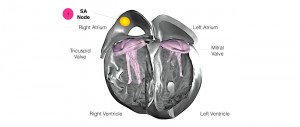
Hypokalemia and hypertension were possibly caused by stress and caffeine. After re-discussing the ECG and the triggering moment, the arrhythmia was re-diagnosed as probable left atrial focal tachycardia, triggered by the ice passing esophagus during a "fragile period“ (stress + excess caffeine + lack of sleep). The patient slept for 6 hours and woke up in the early morning with a sinus rhythm. Treatment was extended with intravenous potassium, magnesium and metoprolol and with oral diazepam.

The arrhythmia was not altered by propafenon, thus DC cardioversion was planned for the next morning. The initial treatment was enoxaparine subcutaneously and propafenon intravenously. The admission diagnosis was atrial flutter. Admission blood pressure was 160/110 mmHg, his potassium level was 3,4 mmol/l, his physical examination and echocardiogram normal. Within 30 minutes, an ECG was recorded (fig. The palpitations started precisely when the ice was passing through his oesophagus. The arrhythmia was triggered after having accidentaly swallowed an ice cube while drinking the last glass of Coke. He was exhausted after overnight work - he had not slept in the last 36 hours and had consumed 7 cups of coffee and 4 glasses of Coka-Cola during this period. The 53-year old normotensive male patient with no previous history of cardiac disease and a normal recent coronary CT scan was admitted for sudden onset of palpitations.

Case descriptionĪs an introduction, I describe an example, of how atrial tachycardia (clearly triggered by external factors) was falsely diagnosed as flutter. However, only rarely do the doctors actually analyse the circumstances which have brought on the arrhythmia.Īvoiding these triggering circumstances might help in preventing future attacks.įurthermore, certain patients are referred for radiofrequency ablation (which is an effective treatment of "classical" atrial flutter), when in fact their true diagnosis is left atrial focal tachycardia - where radiofrequency ablation is substantially more difficult and provides only questionable long-term benefit. It is treated in daily practice mostly with DC cardioversion and subsequent antiarrhythmic drug use. Atrial flutter seems to be an easy electrocardiographic (ECG) diagnosis, which can be done by a medical student.


 0 kommentar(er)
0 kommentar(er)
